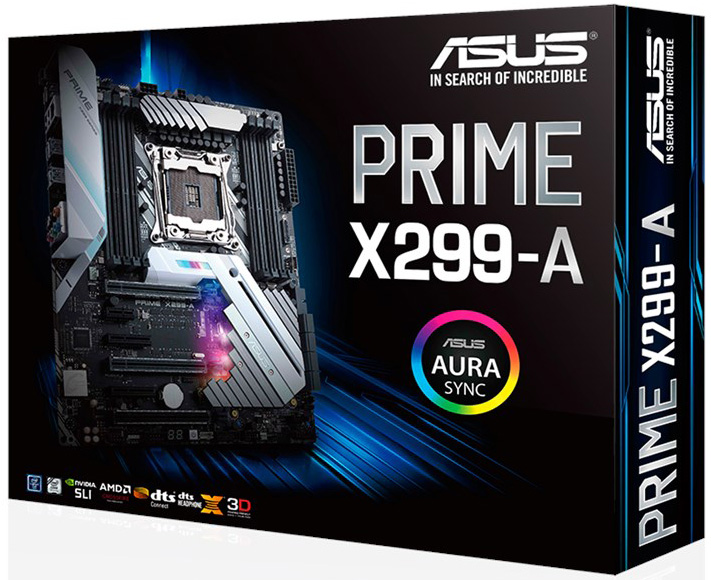Early Verdict
Skylake-X users who won’t run three graphics cards and a slot-mounted PCIe x4 SSD simultaneously will want to give the Prime X299-A some extra consideration. It's a good-to-great value among X299 boards.
Pros
- +
Good CPU overclocking
- +
Great overclocked performance
- +
High efficiency
- +
Cheapest X299 with front-panel USB 3.1 Gen2
Cons
- -
Value-matched (depending on pricing of the day) by its closest competitor
- -
PCIe lane distribution bears examination by serious power users
Why you can trust Tom's Hardware
Specifications & Layout
December 2017 saw emerge what was the one of the most remarkable values in high-end desktop (HEDT) motherboards: The original $260 discount price for Asus’ Prime X299-A dropped to a mere $200. That put the board in Z370 territory, and with added features that would have done a $200 Z370 board proud.
Now, those add-ons are in addition to the benefits X299 offers high-end desktop (HEDT) buyers, including a range of high-core-count processors that boast up to 2.75x the PCI Express (PCIe) lane count. Nobody who is truly serious about building out a high-end PC wants to live within the confines of the Z370 platform’s 16 CPU lanes and four-lane chipset link, and that discount created an opportunity for many buyers to step up to the big leagues of X299.
The short-lived $200 price is history, and we’re not even sure if the $260 price will ever make a comeback. (At this late February 2018 writing, it was hovering in the $275 to $300 range from a variety of notable resellers.) Does the Prime X299-A remain our X299 "value" choice at current pricing? Let's dig in.
Front-panel USB 3.1 Gen 2 is the primary standout on the Prime X299-A’s specifications list. Driven by a second high-end ASM3142 controller, the Prime X299-A is the least expensive X299 board we’ve tested to include it.
Motherboard companies tend to rely on a single circuit board to address lower market segments by leaving off specific controllers and connectors, so we’re surprised to see no solder points within the gaps of the Prime X299-A I/O panel. Since USB 2.0 doesn’t require any of the PCH’s limited HSIO resources, yet is still adequate for keyboards and mice, we're happy to see two of those ports for a keyboard and mouse, in addition to the four USB 3.0 ports, the two USB 3.1 Gen 2 ports with Type-A and Type-C connectors, a USB BIOS Flashback button, the five analog audio jacks, and the single optical S/PDIF output. The digital audio output is bolstered by Asus’ inclusion of DTS Connect, which allows the ALC1220 to combine live multichannel streams to a single output. Without that technology, users of digital receivers would be forced to choose either stereo output for games and multichannel for pre-encoded recordings (such as movies), or resort to a bunch of analog cables.
We need to throw up a caution flag to anyone excited by the Prime X299-A’s slot arrangement: Examine the details in the manual before making any assumptions. For example, the x4 slots: According to Asus, the first x4 slot supports only one lane, and is available with either a 44-lane CPU or if the bottom x16 slot is disabled. (That’s partly because the third x16 slot is x8 only when paired with a 44-lane CPU, whereas both the first x4 slot and the third x16 slot share a lane from the PCH when paired with a 28-lane or 16-lane processor.)
The second x4 slot gets four lanes from a 44-lane CPU. Lacking that, it converts HSIO resources that were previously reserved for SATA to PCIe lanes. That means that users of 28-lane or 16-lane CPUs must choose between using it, or using SATA ports 5 through 8. We’re not sure why the two x4 slots are “swapped” in this manner, but the practical implication is that even users of 44-lane processors can’t use all 44 lanes to feed three double-slot graphics cards and a slot-mounted PCIe x4 SSD, as the slot with four lanes will be covered up, and the uncovered x4 slot will have only one lane. We urge readers likely to push the limits to pore over the motherboard’s documentation.
Get Tom's Hardware's best news and in-depth reviews, straight to your inbox.
A portion of the PCH heat sink comes off to reveal the primary M.2 slot, which, unlike the vertical slot at the top of the board, supports SATA mode in addition to the expected PCIe x4 mode. Also shown in this closeup are “3D Mounts,” meant for printable covers for which Asus hosts the models, two thermistor headers, the VROC interface (which enables software RAID for PCIe drives connected to the CPU), a header for a Thunderbolt upgrade card, and an AC97-style front-panel LED and switch section. The latter has four additional pins set to the right for PC Speaker and AT-style power LEDs. Also heer: three of the board’s seven four-pin fan headers, the solitary USB 2.0 header, one of the two USB 3.0 headers, a five-pin header for an Asus fan extension card (sold separately), an onboard power button, a Port 80 diagnostics display, a legacy serial COM port, and one of the two RGB headers.
The Prime X299-A comes with four SATA cables, a support for a vertical M.2 drive mount next to its primary power connection, an HB-style SLI bridge, and a front-panel extension block that makes it easy to unplug and re-plug the switches and activity LEDs simultaneously. Also in the box: an I/O shield, a driver disc, the manual, and a coupon code for cablemod.com.
MORE: Best Motherboards
MORE: How To Choose A Motherboard
MORE: All Motherboard Content





